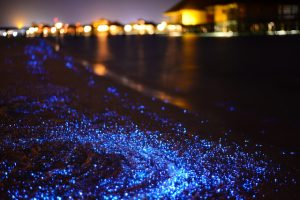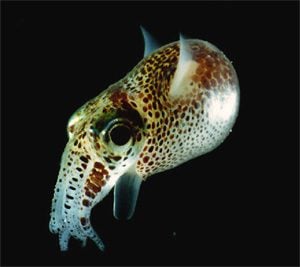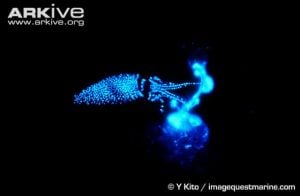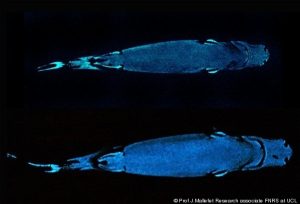Sparkles at midnight
The sea never sleeps. Even at night it is bursting with a wonder that seems almost magical – flashes seeming to appear out of nowhere when the ocean is otherwise shrouded in darkness.
When the lights go out nature doesn’t stop communicating. Similar to our adaptations to cope with the dark, by making light, many organisms have developed the ability to produce light. This is called bioluminescence and is created by a chemical reaction within the organism. It is not the same as fluorescence which results from the organism absorbing light at one wavelength and then re-emitting it at another wavelength. Bioluminescence is therefore an active form of communication, whereas fluorescence is passive communication. Whilst visual light is required to observe fluorescence, bioluminescence can be witnessed in pitch black environments. It is generally blue/green in color and this is due to the shorter blue/green light waves travelling further under water.

Bioluminescence can be found throughout the ocean in many different groups such as jellyfish, sharks, fish, algae and worms to name a few. In each group the chemical reaction that produces the light varies, which is evidence that bioluminescence has evolved multiple times. Generally, bioluminescent animals contain the chemicals required to produce light, but occasionally an animal can take in bacteria or a different bioluminescent organism that has the ability to produce bioluminescence. For example, the Hawaiian bobtail squid takes in bioluminescent bacteria which are stored in a special light organ and at night they then work together to produce light. This light acts as a cloaking device preventing the squid from casting a shadow and hence camouflaging the squid from predators.

For light to be produced organisms must contain the molecule luciferin which when combined with oxygen produces light. Different organisms will contain different types of luciferin. Some organisms can contain a catalyst called luciferase which can speed up the chemical reaction. Additionally, luciferin and oxygen can be bundled together to make a photoprotein which can be activated instantaneously when a certain ion becomes present. The intensity and colour displayed can also vary and this is very important for communication.
Bioluminescent animals can be found on land and in the water column, from the surface to the deepest part of the ocean at challenger deep (10,994m), and in coastal and oceanic environments. In coastal environments around 2.5% of organisms are bioluminescent whereas in pelagic environments the number is significantly higher. Studies estimate that around 70% of fish and 97% of cnidarians (jellyfish, corals, anemones and hydroids) are bioluminescent. Due to the vastness of this form of communication it could be said that bioluminescence may be the most abundant form of communication on earth. Humans see only a small portion of bioluminescence – we generally observe bioluminescence resulting from physical turbulences of the surface water due to waves or boat hulls. The aggravation of the water triggers a bioluminescent response in surface dwelling bioluminescent organisms. One of the most common bioluminescent displays observed by humans is from planktonic surface dwellers. When blooming they form a dense surface layer, which by daylight is reddish-brown in colour but at night transforms into a light display. We can see bioluminescence at Gili Lankanfushi – turn your torch off on a night snorkel and wave your hands around to disturb the water. Bioluminescence is unpredictable but the best times to observe it are when the moon is waning.
Animals can light up for a variety of reasons: to defend themselves, to procure mates and to camouflage or hunt. The dark is an unforgiving place and finding food can be life or death. Some animals concentrate their bioluminescence in a lure and dangle it around their mouths. The deep-sea angler fish has this adaptation – its lure is lit by bioluminescent bacteria. Prey are attracted to the light and can be engulfed before they realise it. The Stauroteuthis octopus which lives below 700m has replaced some of its suckers with bioluminescent cells that direct their planktonic prey into their mouth. The production of light by the cookie-cutter shark tricks whales and squid into venturing closer and once close enough the shark takes a bite out of the animal before it escapes.

Finding a mate in the dark can be a major hardship. Flashing bioluminescent displays can be used as a signal between males and females of the same species to signify the desire to reproduce. For example, a type of male Caribbean crustacean (ostracod) lights up its upper lips to attract females. Long wavelengths like red light are absorbed quickly in the surface waters and it is due to this that many deep sea animals are red – they become invisible. Additionally many organisms have lost the ability to see red light. However, the dragonfish has evolved to emit and see red light. This allows it to see red coloured prey and also they can light up the surrounding water to hunt or look for a mate.
Even though bioluminescence lights up the darkness it can be used for protection and camouflage. Many animals will produce a strong flash of light to confuse predators and swim off whilst the predator is blinded. Some squid can produce bioluminescent ink – upon ejection it can stick to the predator and light it up. This can lead to the predator becoming a meal for something even larger. If a predator manages to take a bite out of a bioluminescent organism the stomach of that predator will glow making it an easy target and giving the prey time to escape.

Bioluminescence can also be used for counter illumination. This is where the animal can manipulate light to prevent itself producing a shadow and making it almost invisible. They can use bioluminescence to match the light coming from the surface. This makes it almost impossible for predators below to see their prey. The lantern shark is an example of this – it can make itself look invisible by producing blue/green light to blend in with the background.
It’s surprising how any organisms create light, even in an aquarium you may notice it. Next time you are at Gili Lankanfushi try and see the bioluminescence yourself. You never know when the next flash of light will catch you by surprise!
